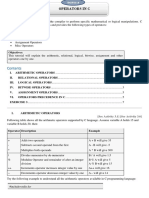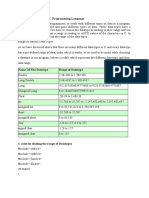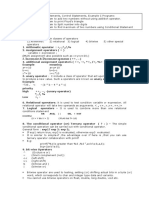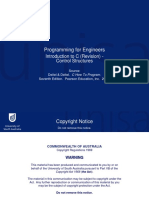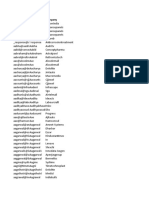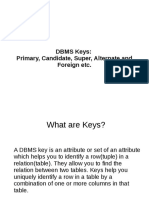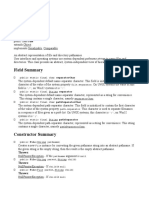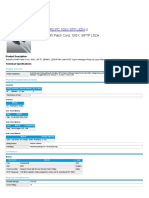PROGRAMMING FOR PROBLEM SOLVING USING C
UNIT II
Bitwise Operators: Exact Size Integer Types, Logical Bitwise Operators, Shift Operators, Tips and
Common Programming Errors, Key Terms, Summary, Practice Set.
Selection & Making Decisions: Logical Data and Operators, Two Way Selection, Multiway
Selection, More Standard Functions, Tips and Common Programming Errors, Key Terms,
Summary, Practice Set.
Repetition: Concept of Loop, Pretest and Post-test Loops, Initialization and Updating, Event and
Counter Controlled Loops, Loops in C, Other Statements Related to Looping, Looping Applications,
Programming Example The Calculator Program, Tips and Common Programming Errors, Key
Terms, Summary, Practice Set.
Bitwise Operators:-
These operators are used to perform bit operations. Decimal values are
converted into binary values which are the sequence of bits and bit wise
operators work on these bits.
Bit wise operators in C language are & (bitwise AND), | (bitwise OR), ~
(bitwise NOT), ^ (XOR), << (left shift) and >> (right shift).
TRUTH TABLE FOR BIT WISE OPERATION & BIT WISE OPERATORS
BELOW ARE THE BIT-WISE OPERATORS AND THEIR NAME IN C LANGUAGE.
1. & – Bitwise AND
2. | – Bitwise OR
3. ~ – Bitwise NOT
4. ^ – XOR
5. << – Left Shift
6. >> – Right Shift
www.Jntufastupdates.com 1
� Exact Size Integer Types:-
The following table provides the details of standard integer types with their
storage sizes and value ranges −
Type Storage size Value range
char 1 byte -128 to 127 or 0 to 255
unsigned char 1 byte 0 to 255
signed char 1 byte -128 to 127
int 2 or 4 bytes -32,768 to 32,767 or -2,147,483,648 to 2,147,483,647
unsigned int 2 or 4 bytes 0 to 65,535 or 0 to 4,294,967,295
short 2 bytes -32,768 to 32,767
unsigned short 2 bytes 0 to 65,535
long 8 bytes -9223372036854775808 to 9223372036854775807
unsigned long 8 bytes 0 to 18446744073709551615
Bitwise operators are used for manipulating a data at the bit
level, also called as bit level programming. Bit-level
programming mainly consists of 0 and 1. They are used in
numerical computations to make the calculation process
faster.
Following is the list of bitwise operators provided by 'C'
programming language:
Operators Example/Description
&& (logical (x>5)&&(y<5)
AND) It returns true when both conditions are true
(x>=10)||(y>=10)
|| (logical OR) It returns true when at-least one of the condition is true
!((x>5)&&(y<5))
It reverses the state of the operand “((x>5) && (y<5))”
! (logical NOT) If “((x>5) && (y<5))” is true, logical NOT operator makes it false
Shift Operators:-
Bitwise Right Shift Operator in C :-
1.It is denoted by >>
www.Jntufastupdates.com 2
� 2. Bit Pattern of the data can be shifted by specified number of
Positions to Right.
3. When Data is Shifted Right , leading zero’s are filled with
zero.
4. Right shift Operator is Binary Operator [Bi – two]
5.Binary means , Operator that require two arguments
Bitwise Left Shift Operator in C :-
<< (left shift) Takes two numbers, left shifts the bits of the first
operand, the second operand decides the number of places to shift.
Or in other words left shifting an integer “x” with an integer “y” (x<<y)
is equivalent to multiplying x with 2^y (2 raise to power y).
Important Points:-
The left shift and right shift operators should not be used for negative
numbers. The result of is undefined behaviour if any of the operands
is a negative number. For example results of both -1 << 1 and 1 << -1
is undefined.
If the number is shifted more than the size of integer, the behaviour is
undefined. For example, 1 << 33 is undefined if integers are stored
using 32 bits. See this for more details.
The left-shift by 1 and right-shift by 1 are equivalent to multiplication
and division by 2 respectively.
Selection & Making Decisions:-
Decision making structures require that the programmer specifies
one or more conditions to be evaluated or tested by the program,
along with a statement or statements to be executed if the
condition is determined to be true, and optionally, other
statements to be executed if the condition is determined to be
false.
Show below is the general form of a typical decision making
structure found in most of the programming languages –
www.Jntufastupdates.com 3
� C programming language assumes any non-zero and non-
null values as true, and if it is either zero or null, then it is
assumed as false value.
1. If Statement
“If statement” is the selection statement used to select course of action depending
on the conditions given. Therefore programmers can use this statement to control
the flow of their program.
The syntax of the if statement in C programming is:
if (test expression)
{
// statements to be executed if the test expression is true
}
2. C if...else Statement
The if statement may have an optional else block. The syntax of
the if..else statement is:
if (test expression) {
// statements to be executed if the test expression is true
}
else {
// statements to be executed if the test expression is false
}
Nested if...else
It is possible to include an if..else statement inside the body of
another if...else statement.
www.Jntufastupdates.com 4
� Logical Data and Operators:-
Following table shows all the logical operators supported by C
language. Assume variable A holds 1 and variable B holds 0, then
Operator Description Example
&& Called Logical AND operator. If both the operands are non-zero, (A && B)
then the condition becomes true. is false.
|| Called Logical OR Operator. If any of the two operands is non- (A || B) is
zero, then the condition becomes true. true.
! Called Logical NOT Operator. It is used to reverse the logical !(A &&
state of its operand. If a condition is true, then Logical NOT B) is
operator will make it false. true.
Try the following example to understand all the logical operators available in C −
#include <stdio.h>
main() {
int a = 5;
int b = 20;
int c ;
if ( a && b ) {
printf("Line 1 - Condition is true\n" );
}
if ( a || b ) {
printf("Line 2 - Condition is true\n" );
}
/* lets change the value of a and b */
a = 0;
b = 10;
if ( a && b ) {
printf("Line 3 - Condition is true\n" );
} else {
printf("Line 3 - Condition is not true\n" );
}
if ( !(a && b) ) {
printf("Line 4 - Condition is true\n" );
}
}
Line 1 - Condition is true
Line 2 - Condition is true
Line 3 - Condition is not true
Line 4 - Condition is true
www.Jntufastupdates.com 5
�When you compile and execute the above program, it produces the following result −
Line 1 - Condition is true
Line 2 - Condition is true
Line 3 - Condition is not true
Line 4 - Condition is true
Two Way Selection:-
The two-way selection is the basic decision statement for
computers.
The decision is based on resolving a binary expression, and then
executing a set of commands depending on whether the response
was true or false.
C, like most contemporary programming languages, implements
two-way selection with the if…else statement.
Multi-Way Selection:-
A multi-way selection statement is used to execute at most ONE of the choices
of a set of statements presented.
Syntax of the multi-way select statement:
Switch (Expression)
{
Case Constant1, one or more statements; break;
Case constant2, one or more statements; break;
........
[ default : one or more statements;]
}
More Standard Functions:-
The standard functions are built-in functions. In C
programming language, the standard functions are declared in
header files and defined in .dll files.
In simple words, the standard functions can be defined as "the
ready made functions defined by the system to make coding
more easy".
The standard functions are also called as library
functions or pre-defined functions.
in C when we use standard functions, we must include the
respective header file using #include statement.
www.Jntufastupdates.com 6
� For example, the function printf() is defined in header
file stdio.h (Standard Input Output header file).
When we use printf() in our program, we must
include stdio.h header file using #include<stdio.h> statement
C Programming Language provides the following header files
with standard functions.
<ctype.h> character testing and conversion functions.
<math.h> Mathematical functions
<stdio.h> standard I/O library functions
<stdlib.h> Utility functions such as string conversion routines memory
allocation routines , random number generator,etc.
<string.h> string Manipulation functions
<time.h> Time Manipulation functions
MATH.H
abs : returns the absolute value of an integer x
cos : returns the cosine of x, where x is in radians
exp: returns "e" raised to a given power
fabs: returns the absolute value of a float x
log: returns the logarithm to base e
log10: returns the logarithm to base 10
pow : returns a given number raised to another number
sin : returns the sine of x, where x is in radians
sqrt : returns the square root of x
Repetition:-
Concept of Loop:-
In looping, a program executes the sequence of statements
many times until the stated condition becomes false. A loop
consists of two parts, a body of a loop and a control statement.
The control statement is a combination of some conditions that
direct the body of the loop to execute until the specified
condition
Types of Loops
Depending upon the position of a control statement in a program, a loop
is classified into two types:
1. Entry controlled loop
2. Exit controlled loop
www.Jntufastupdates.com 7
� In an entry controlled loop, a condition is checked before executing the
body of a loop. It is also called as a pre-checking loop.
In an exit controlled loop, a condition is checked after executing the
body of a loop. It is also called as a post-checking loop
The control conditions must be well defined and specified otherwise the
loop will execute an infinite number of times.
'C' programming language provides us with three types of loop
constructs:
1. The while loop
2. The do-while loop
3. The for loop
While Loop
A while loop is the most straightforward looping structure. The basic
format of while loop is as follows:
While (condition )
{
Statements;
}
It is an entry-controlled loop. In while loop, a condition is evaluated
before processing a body of the loop.
Following program illustrates a while loop:
#include<stdio.h>
www.Jntufastupdates.com 8
�#include<conio.h>
int main()
{
int num=1; //initializing the variable
while(num<=10) //while loop with condition
{
printf("%d\n",num);
num++; //incrementing operation
}
return 0;
}
Output:
1
2
3
4
5
6
7
8
9
10
Do-While loop
A do-while loop is similar to the while loop except that the condition is always
executed after the body of a loop. It is also called an exit-controlled loop.
The basic format of while loop is as follows:
do {
statements
} while (expression);
As we saw in a while loop, the body is executed if and only if the
condition is true. In some cases, we have to execute a body of the loop
at least once even if the condition is false. This type of operation can be
achieved by using a do-while loop
In the do-while loop, the body of a loop is always executed at least once.
After the body is executed, then it checks the condition. If the condition
is true, then it will again execute the body of a loop otherwise control is
transferred out of the loop.
www.Jntufastupdates.com 9
�The following program illustrates the working of a do-while loop:
#include<stdio.h>
#include<conio.h>
int main()
{
int num=1; //initializing the variable
do //do-while loop
{
printf("%d\n",2*num);
num++; //incrementing operation
}while(num<=10);
return 0;
}
Output:
2
4
6
8
10
12
14
16
18
20
For loop
A for loop is a more efficient loop structure in 'C' programming. The
general structure of for loop is as follows:
for (initial value; condition; incrementation or decrementation )
{
statements;
}
The initial value of the for loop is performed only once.
The condition is a Boolean expression that tests and compares the
counter to a fixed value after each iteration, stopping the for loop
when false is returned.
The incrementation/decrementation increases (or decreases) the
counter by a set value.
Following program illustrates the use of a simple for loop:
#include<stdio.h>
int main()
{
int number;
for(number=1;number<=10;number++) //for loop to print 1-10 numbers
{
printf("%d\n",number); //to print the number
}
return 0;
www.Jntufastupdates.com 10
� }
Output:
1
2
3
4
5
6
7
8
9
10
Pretest and Post-test Loops:-
Initialization:-
Initialization is the process of locating and using the defined values
for variable data that is used by a computer program. For example,
an operating system or application program is installed with default
or user-specified values that determine certain aspects of how the
system or program is to function.
The process of the user specifying initialization values is
sometimes called configuration.
Event and Counter Controlled Loops:-
The Event-Controlled while loop
In this while loop an action is repeated until a certain event occurs. This is
by far the most frequently used form of the while loop.
There are three different types of Event-Controlled while loops
www.Jntufastupdates.com 11
� 1. Sentinel-controlled loops - A sentinel variable is initialized to a specific
value. The while loop continues until, through some action inside the loop,
the sentinel variable is set to a predefined termination value.
2. End-of-file controlled loops - This type of while loop is usually used when
reading from a file. The loop terminates when the end of the file is
detected. This can easily be determined by checking the EOF() function
after each read from the file. This function will return true when the end-
of-file is reached.
3. Flag controlled loops - A bool variable is defined and initialized to serve as
a flag. The while loop continues until the flag variable value flips (true
becomes false or false becomes true).
Count-Controlled Repetition:-
Count-controlled repetition requires
control variable (or loop counter)
initial value of the control variable
increment (or decrement) by which the control variable is modified each
iteration through the loop
condition that tests for the final value of the control variable
A count-controlled repetition will exit after running a certain number of
times. The count is kept in a variable called an index or counter.
When the index reaches a certain value (the loop bound) the loop will end.
Count-controlled repetition is often called definite repetition because the
number of repetitions is known before the loop begins executing.
Other Statements Related to Looping:-
break and continue:-
break and continue are two C/C++ statements that allow us to further
control flow within and out of loops.
break causes execution to immediately jump out of the current loop, and
proceed with the code following the loop.
continue causes the remainder of the current iteration of the loop to be
skipped, and for execution to recommence with the next iteration.
www.Jntufastupdates.com 12
� In the case of for loops, the incrementation step will be executed next,
followed by the condition test to start the next loop iteration.
In the case of while and do-while loops, execution jumps to the next
loop condition test.
Infinite Loops:-
Infinite loops are loops that repeat forever without stopping.
Usually they are caused by some sort of error, such as the following
example in which the wrong variable is incremented:
int i, j;
for( i = 0; i < 5; j++ )
printf( "i = %d\n", i );
printf( "This line will never execute\n" );
Nested Loops
The code inside a loop can be any valid C code, including other loops.
Any kind of loop can be nested inside of any other kind of loop.
Looping Applications:-
Why do we use looping in programming?
Because we want to repeat something:
Count from 1 to 10.
Go through all the words in a dictionary to see whether they’re
palindromes.
For each customer that has an outstanding balance, send out an
email reminder that payment is due.
For each directory under this one, find music files and add then
to the list of known music.
The Calculator Program:-
/*C program to design calculator with basic operations using switch.*/
#include <stdio.h>
int main()
{
int num1,num2;
float result;
char ch; //to store operator choice
www.Jntufastupdates.com 13
� printf("Enter first number: ");
scanf("%d",&num1);
printf("Enter second number: ");
scanf("%d",&num2);
printf("Choose operation to perform (+,-,*,/,%): ");
scanf(" %c",&ch);
result=0;
switch(ch)
{
case '+':
result=num1+num2;
break;
case '-':
result=num1-num2;
break;
case '*':
result=num1*num2;
break;
case '/':
result=(float)num1/(float)num2;
break;
case '%':
result=num1%num2;
break;
default:
printf("Invalid operation.\n");
}
printf("Result: %d %c %d = %f\n",num1,ch,num2,result);
return 0;
}
Output
Enter first number: 10
Enter second number: 20
Choose operation to perform (+,-,*,/,%): +
Result: 10 + 20 = 30.000000
Enter first number: 10
Enter second number: 3
Choose operation to perform (+,-,*,/,%): /
Result: 10 / 3 = 3.333333
Enter first number: 10
www.Jntufastupdates.com 14
�Enter second number: 3
Choose operation to perform (+,-,*,/,%): >
Invalid operation.
Result: 10 > 3 = 0.000000
The End
www.Jntufastupdates.com 15












